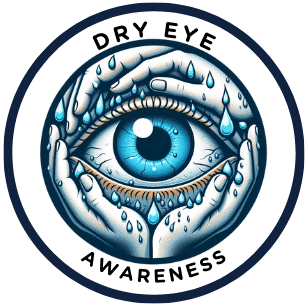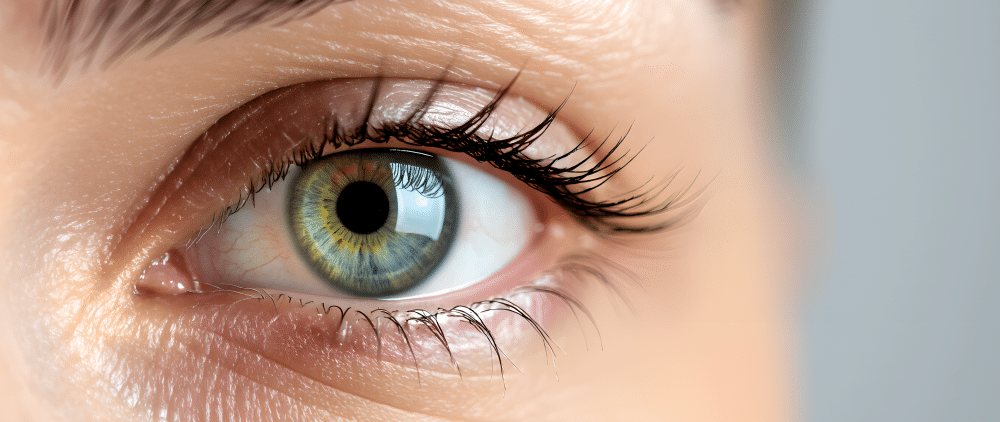
If you’ve been struggling with dry, irritated eyes that just won’t seem to get better, blepharitis might be the underlying culprit. This common but often overlooked eyelid condition affects over 37 million Americans and plays a significant role in chronic dry eye symptoms. Understanding the connection between blepharitis and dry eyes is crucial for finding effective treatment and achieving long-term relief from uncomfortable eye symptoms.
What is Blepharitis? (Complete Definition)
Blepharitis is a chronic inflammatory condition that affects the eyelids, specifically the areas along the eyelid margins where the eyelashes grow. The term comes from the Greek words “blepharon” (eyelid) and “itis” (inflammation). This condition involves inflammation of the eyelid structures, which can affect the front edge of the eyelid, the oil-producing glands, or both, leading to red, swollen, and irritated eyelids.
Blepharitis affects approximately 47% of people who visit eye care professionals, making it one of the most common eye conditions. The condition can occur at any age but becomes more prevalent with aging.
Types of Blepharitis
There are two main types of blepharitis that eye doctors diagnose:
Anterior Blepharitis affects the outside front edge of the eyelid where the eyelashes attach. This type is often associated with bacteria or dandruff of the scalp and eyebrows.
Posterior Blepharitis affects the inner edge of the eyelid that touches the eye. This form involves the meibomian glands, which produce the oily layer of tears, and is also known as meibomian gland dysfunction (MGD).
Blepharitis and Dry Eye Connection: Why They Occur Together
Blepharitis and dry eye disease are intimately connected, often creating a cycle where one condition worsens the other. Research shows that up to 86% of dry eye patients also have blepharitis, highlighting the strong relationship between these conditions.
The meibomian glands in your eyelids produce oils that form the outermost layer of your tear film. This oily layer prevents tears from evaporating too quickly and keeps your eyes properly lubricated.
How Blepharitis Causes Dry Eyes
When blepharitis affects these glands, several problems occur:
- The glands become blocked or inflamed, reducing oil production
- The quality of the oil changes, making it less effective at preventing tear evaporation
- Tears evaporate more rapidly, leading to dry eye symptoms
- The unstable tear film causes further irritation and inflammation
- Chronic inflammation can damage the glands permanently over time
This creates a vicious cycle: blepharitis causes dry eyes, and dry eyes can worsen blepharitis symptoms through increased inflammation and irritation.
What Causes Blepharitis? (Common Risk Factors)
Understanding the causes of blepharitis can help you identify risk factors and take preventive measures. The condition typically results from a combination of factors:
Bacterial Overgrowth and Infection
Normal bacteria that live on the skin can multiply excessively around the eyelids, particularly Staphylococcus bacteria. These bacteria produce toxins and enzymes that irritate the eyelids and disrupt normal gland function.
Skin Conditions That Trigger Blepharitis
Several dermatological conditions increase the risk of developing blepharitis:
- Seborrheic dermatitis (dandruff)
- Rosacea
- Eczema
- Psoriasis
Meibomian Gland Dysfunction
Age-related changes, hormonal fluctuations, and certain medications can affect the consistency and flow of oils produced by the meibomian glands, leading to blockages.
Environmental and Lifestyle Factors
- Poor eyelid hygiene
- Use of contaminated eye makeup or brushes
- Contact lens wear
- Exposure to smoke, wind, or dry air
- Excessive screen time
- Certain medications that reduce oil production
Underlying Health Conditions
- Diabetes
- Thyroid disorders
- Autoimmune conditions
- Hormonal changes (particularly in women during menopause)
Blepharitis Symptoms: How to Recognize the Signs
Blepharitis symptoms can vary in severity and may affect one or both eyes. Early recognition of these signs can lead to faster treatment and better outcomes. Common symptoms include:
Eyelid-Specific Symptoms:
- Red, swollen eyelids (blepharitis redness)
- Itching or burning sensation along the eyelid margin
- Flaky, scaly skin around the eyes (similar to dandruff)
- Crusting along the eyelid margins, especially upon waking
- Sticky or greasy eyelids
- Eyelid swelling and tenderness
Associated Dry Eye Symptoms:
- Red, swollen eyelids
- Itching or burning sensation
- Flaky, scaly skin around the eyes
- Crusting along the eyelid margins, especially upon waking
- Sticky or greasy eyelids
Eye-Related Symptoms:
- Dry, gritty feeling in the eyes
- Excessive tearing
- Feeling like something is in your eye
- Sensitivity to light
- Blurred vision
- Frequent blinking
Other Signs:
- Eyelashes that fall out easily
- Growth of eyelashes in abnormal directions
- Styes or chalazia (small lumps on the eyelid)
Blepharitis Treatment Options: From Home Care to Professional Therapy
Treating blepharitis effectively requires a multi-faceted approach that addresses both the underlying inflammation and the associated dry eye symptoms. The good news is that with proper blepharitis treatment, most people can achieve significant improvement in their symptoms within 2-4 weeks.
At-Home Blepharitis Treatment
The cornerstone of blepharitis treatment at home is establishing a consistent eyelid cleaning routine:
Warm Compresses for Blepharitis: Apply warm, moist compresses (#ad) to closed eyelids for 10-15 minutes daily. This helps soften hardened oils in the meibomian glands and makes cleaning more effective. Use water heated to 104-108°F (40-42°C) for optimal results. (As an Amazon Associate I earn a commission from qualifying purchases. You do not pay any more as a result)

Eyelid Scrubs and Cleaning: Gently clean the eyelid margins using diluted baby shampoo, commercial eyelid cleansers, or prescribed solutions. Use a clean cotton swab or washcloth to remove debris and bacteria. You can also use commercially available lid scrubs (#ad). In addition to lid scrubs I recommend Hypochlor Eyelid Spray (#ad) to all of my patients who have blepharitis. This should be applied before going to bed at night. Just spray it on your closed eyelids and let dry.
Lid Massage Technique: After warm compresses, gently massage the eyelids using circular motions to help express oils from the meibomian glands.
Medical Treatments
Depending on the severity and type of blepharitis, your eye care professional may recommend:
Topical Antibiotics: Antibiotic ointments or drops can help control bacterial overgrowth and reduce inflammation.
Oral Antibiotics: For more severe cases or those with associated rosacea, oral antibiotics like doxycycline may be prescribed for their anti-inflammatory properties.
Anti-inflammatory Medications: Steroid eye drops may be used short-term to reduce severe inflammation.
Artificial Tears: High-quality preservative-free artificial tears (#ad) help manage dry eye symptoms associated with blepharitis.
Advanced Treatment Options
For persistent or severe cases, several advanced treatments are available:
IPL (Intense Pulsed Light) Therapy: This treatment uses light energy to reduce inflammation and improve meibomian gland function.
LipiFlow Treatment: A device that applies controlled heat and pressure to unblock meibomian glands.
BlephEx Treatment: A professional deep-cleaning procedure that removes biofilm and debris from the eyelid margins.
Prescription Medications: Cyclosporine drops (Restasis) or lifitegrast drops (Xiidra) may be prescribed for associated dry eye disease.
Lifestyle Modifications
Making certain lifestyle changes can significantly improve treatment outcomes:
- Maintain good overall hygiene, especially around the face and hair
- Replace eye makeup regularly and avoid sharing cosmetics
- Take omega-3 fatty acid supplements, which may help improve oil gland function
- Use a humidifier in dry environments
- Follow the 20-20-20 rule during screen time (look at something 20 feet away for 20 seconds every 20 minutes)
- Avoid rubbing or touching your eyes
Prevention and Long-term Management
Blepharitis is often a chronic condition that requires ongoing management rather than a one-time cure. However, with proper care, symptoms can be well-controlled:
Consistency is Key: Maintain your daily eyelid hygiene routine even when symptoms improve.
Regular Check-ups: Schedule regular eye exams to monitor your condition and adjust treatment as needed.
Identify Triggers: Pay attention to factors that worsen your symptoms and work to avoid them.
Early Intervention: Address flare-ups promptly with intensified treatment to prevent worsening.
When to Seek Professional Help

While mild blepharitis can often be managed with good hygiene practices, you should consult an eye care professional if you experience:
- Persistent symptoms despite consistent home care
- Severe pain or vision changes
- Signs of infection (increased redness, swelling, or discharge)
- Recurring styes or chalazia
- Symptoms that significantly impact your quality of life
Frequently Asked Questions About Blepharitis and Dry Eyes
Is blepharitis contagious?
No, blepharitis is not contagious. It’s an inflammatory condition caused by blocked oil glands and bacterial overgrowth, not an infection that spreads from person to person.
How long does blepharitis last?
Blepharitis is typically a chronic condition that requires ongoing management. However, with consistent treatment, symptoms usually improve within 2-4 weeks and can be well-controlled long-term.
Can blepharitis cause permanent vision loss?
While blepharitis itself rarely causes permanent vision loss, severe untreated cases can lead to complications like corneal damage or chronic dry eye that may affect vision quality.
What’s the best eye drops for blepharitis?
The best eye drops depend on your specific symptoms. Preservative-free artificial tears help with dryness, while antibiotic drops or ointments may be prescribed for bacterial overgrowth. Consult an eye doctor for personalized recommendations.
Can diet help with blepharitis?
Yes, omega-3 fatty acids found in fish oil supplements may help improve meibomian gland function. Anti-inflammatory foods and staying hydrated can also support overall eye health.
The Path to Relief
Take Control of Your Blepharitis and Dry Eye Symptoms Today
Understanding the connection between blepharitis and dry eyes is the first step toward finding effective treatment. While this condition can be frustrating and persistent, the right combination of professional care, consistent hygiene practices, and appropriate treatments can provide significant relief from uncomfortable symptoms.
Key takeaways for managing blepharitis:
- Establish a daily eyelid hygiene routine with warm compresses and gentle cleaning
- Seek professional evaluation if symptoms persist despite home treatment
- Consider advanced treatments like IPL therapy or LipiFlow for severe cases
- Maintain consistent treatment even when symptoms improve to prevent flare-ups
Remember that blepharitis treatment is not one-size-fits-all. What works best for you may require some trial and adjustment under the guidance of your eye care professional. With patience and proper management, most people with blepharitis can achieve comfortable, healthy eyes and improved quality of life.
Don’t let blepharitis control your life. If you’re struggling with persistent dry eye symptoms, don’t overlook the possibility of blepharitis. A thorough evaluation by an eye care professional can help identify this often-overlooked condition and set you on the path to clearer, more comfortable vision.
This article is for informational purposes only and should not replace professional medical advice. Always consult with a qualified eye care professional for proper diagnosis and treatment of dry eye syndrome.

